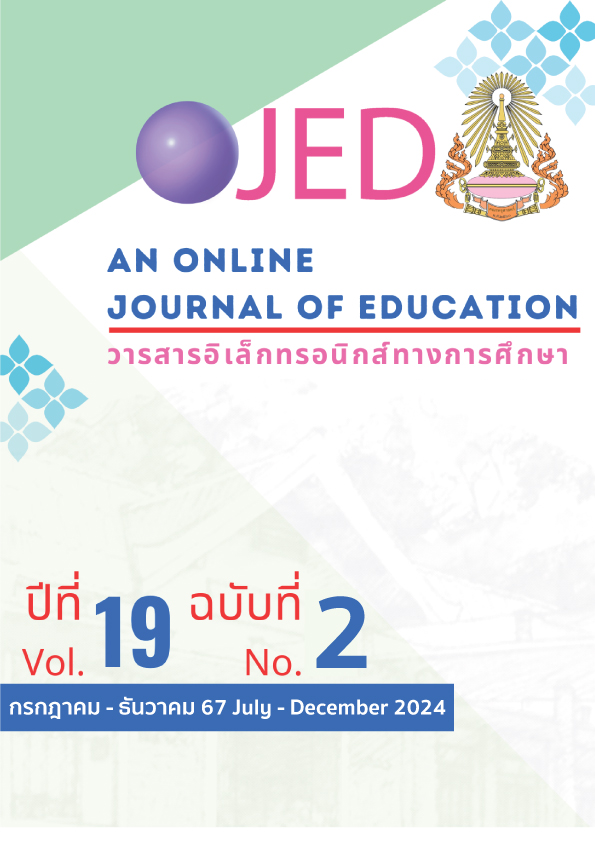Effects of Organizing Mathematics Learning Activities Using MEAs Model on Analytical Thinking Ability of Lower Secondary Students
DOI:
https://doi.org/10.14456/ojed.2024.3Keywords:
MEAs model, Model Eliciting Activities, Analytical thinking ability, problem-based learning (PBL), elicit, mathematical representationsAbstract
The purposes of this research were: 1) to compare the analytical thinking ability of students before and after learning through the MEAs model, and 2) to compare the analytical thinking ability of students after learning through the MEAs model to the 60 percent criterion. The subjects were obtained through purposive sampling and consisted of 33 ninth grade students from a large school in Chiang Rai. The instruments used for research included 14 lesson plans and both a pre-test and post-test on analytical thinking ability. Data were analyzed using statistical mean, standard deviation, percentage, and t-test. The results of the research revealed that: 1) the analytical thinking ability of students after learning through the MEAs model were higher than the pre–learning state at the .05 level of significance, in terms of both overall performance and in each specific aspect, and 2) the analytical thinking abilities of students after learning through the MEAs model were higher than the 60% benchmark at the .05 level of significance, both in terms of overall performance and in the matching, classification, and analysis error dimensions. However, regarding the summarizing and application dimensions, their abilities were higher than the 60% criterion yet not statistically significant.
References
ภาษาไทย
กระทรวงศึกษาธิการ. (2551). ตัวชี้วัดและสาระแกนกลางกลุ่มสาระการเรียนรู้คณิตศาสตร์ ตามหลักสูตรแกนกลางการศึกษาขั้นพื้นฐาน พุทธศักราช 2551. โรงพิมพ์ชุมนุมสหกรณ์การเกษตรแห่งประเทศไทย.
เกรียงศักดิ์ เจริญวงศ์ศักดิ์. (2546). การคิดเชิงวิเคราะห์. ซัสเซส มีเดีย.
ชาญชัย ยมดิษฐ์. (2548). เทคนิคและวิธีการสอนร่วมสมัย (พิมพ์ครั้งที่ 1 ). หลักพิมพ์.
ชาติ แจ่มนุช. (2545). สอนอย่างไรให้คิดเป็น. เลี่ยงเชียง.
ซูรายา สัสดีวงศ์. (2555). การพัฒนากระบวนการจัดการเรียนรู้โดยบูรณาการรูปแบบการพัฒนา ความคิดทางคณิตศาสตร์และแนวคิดการใช้ปัญหาเป็นหลักเพื่อส่งเสริมความสามารถในการคิด วิเคราะห์และความสามารถในการอก้ปัญหาทางคณิตศาสตร์ของนักเรียนชั้นมัธยมศึกษาทาง คณิตศาสตร์ของนักเรียนชั้นมัธยมศึกษาปีที่ 2 [วิทยานิพนธ์ปริญญามหาบัณฑิต]. จุฬาลงกรณ์มหาวิทยาลัย. Chulalongkorn University Intellectual Repository (CUIR). https://cuir.car.chula.ac.th/bitstream/123456789/45041/1/suraya_sa.pdf
ทิศนา แขมมณี และจุฬาลงกรณ์มหาวิทยาลัย ภาควิชาประถมศึกษา. (2544). วิทยาการด้านการคิด. เดอะมาสเตอร์กรุ๊ปแมเนจเม้นท์.
รัญชนา ทรงไชย และ จุไรรัตน์ อาจแก้ว. (2561). การเปรียบเทียบผลสัมฤทธิ์ทางการเรียนและความสามารถในการคิดวิเคราะห์ทางคณิตศาสตร์ของนักเรียนระดับชั้นประถมศึกษาปีที่ 5 ระหว่างรูปแบบการจัดการเรียนรู้โดยใช้ปัญหาเป็นฐาน(PBL) และการจัดการเรียนรู้ตามปกติ. วารสารมนุษยศาสตร์และสังคมศาสตร์ มหาวิทยาลัยพะเยา, 7(2), 24-41.
ลักขณา สริวัฒน์. (2549). การคิด. โอเดียนสโตร์.
ศูนย์ดำเนินงาน PISA แห่งชาติ สถาบันส่งเสริมการสอนวิทยาศาสตร์และเทคโนโลยี. (2564). ผลการประเมิน PISA 2018 การอ่าน คณิตศาสตร์ และวิทยาศาสตร์. สถาบันส่งเสริมการสอนวิทยาศาสตร์และเทคโนโลยี (สสวท.).
สุคนธ์ สินธพานนท์, วรรัตน์ วรรณเลิศลักษณ์, และ พรรณี สินธพานนท์. (2550). พัฒนาทักษะการคิดพิชิตการสอน. กรุงเทพฯ: จุฬาลงกรณ์มหาวิทยาลัย.
สิรินทรา มินทะขัติ. (2556). ผลของการจัดกิจกรรมการเรียนรู้โดยใช้ปัญหาเป็นฐาน (Problem-based learning) เรื่อง พื้นที่ผิวและปริมาตร ที่มีต่อความสามารถในการคิดวิเคราะห์ และความสามารถในการให้เหตุผลทางคณิตศาสตร์ของนักเรียนชั้นมัธยมศึกษาปีที่ 3 [วิทยานิพนธ์ปริญญามหาบัณฑิต]. มหาวิทยาลัยศรีนครินทรวิโรฒ. https://ir.swu.ac.th/jspui/handle/123456789/4275
สุวิทย์ มูลคํา. (2547). กลยุทธ์การสอนคิดประยุกต์. ภาพพิมพ์.
อัมพร ม้าคนอง. (2553). ทักษะและกระบวนการทางคณิตศาสตร์: การพัฒนาเพื่อพัฒนาการ. โรงพิมพ์แห่งจุฬาลงกรณ์มหาวิทยาลัย.
ภาษาอังกฤษ
Aziz, S. A., & Irwan, I. (2020). Validity Of Mathematical Learning Material Based On Model Eliciting Activities
(MEAS) Approach To Improve Mathematical Creative Thinking Skill Of Students. Journal of Physics:
Conference Series, 1554, 012066. https://doi.org/10.1088/1742-6596/1554/1/012066 Bloom, B. S. (1956). Taxonomy of education objective Book 1: Cognitive domain. Longman Group.
Chamberlin, S. A., & Coxbill, E. (2012). Using model-eliciting activities to introduce upper elementary students to statistical reasoning and mathematical modeling. WISDOMe Monograph Series Volume 2, 169-195. Retrieved from https://www.researchgate.net/publication/315831146_Quantitative_Reasoning_and_Mathematical_Modeling_A_Driver_for_STEM_Integrated_Education_and_Teaching_in_Context
Chamberlin, S. A., & Moon, S. M. (2005). Model-eliciting activities as a tool to develop and identify creatively gifted mathematicians. Journal of Secondary Gifted Education, 17(1), 37-47.
Clark, L. H. (1968). Strategies and tactics in secondary school teaching: a book of readings. Macmillan Company.
Coxbill, E., Chamberlin, S. A., & Weatherford, J. (2013). Using model-eliciting activities as a tool to identify and develop mathematically creative students. Journal for the Education of the Gifted, 36(2), 176-197.
Good, C. V. (1973). Dictionary of education (Vol. 3). McGraw-Hill Book Company.
Hartati, S., Bilqis, R. A., & Rinaldi, A. (2020). Mathematical problem-solving abilities and reflective thinking abilities: The impact of the influence of eliciting activities models. Al-Jabar: Jurnal Pendidikan Matematika, 11(1), 167-178.
Wahyu, H. 2014 The Implementation of MEAs Instruction to Students’ Mathematics Problem Solving and Connecting Ability Proceeding of International Conference On Research, Implementation, And Education Of Mathematics And Sciences, 607 – 614.
Irwan, & Al Aziz, S. (2018). The Influence of Mathematical Learning Material Based On Model-Eliciting Activities (MEAs) Approach To Improve Mathematical Creative Thinking Skill Of Students Of Grade X Of Senior High School Padang. Proceedings of the 2nd International Conference on Mathematics and Mathematics Education 2018 (ICM2E 2018, France, Europe.), Volume 285, 117-120. https://www.atlantis-press.com/proceedings/icm2e-18/55909487.
Lesh, R., Hoover, M., Hole, B., Kelly, A., & Post, T., (2000) Principles for Developing Thought-Revealing Activities for Students and Teachers. In A. Kelly, R. Lesh (Eds.), Research Design in Mathematics and Science Education. (pp. 591-646). Lawrence Erlbaum Associates, Mahwah, New Jersey.
Lesh, R., & English, L. D. (2005). Trends in the evolution of models & modeling perspectives on mathematical
learning and problem solving. Zentralblatt Für Didaktik Der Mathematik, 37(6), 487–489.
https://doi.org/10.1007/bf02655857
Marzano, R. J. (2001). Designing a new taxonomy of educational objectives. Corwin Press and London: Sage.
Moon, S. (2008). How Does the Problem Based Learning Approach Compare to the Model-Eliciting Activity Approach in Mathematics? https://www.cimt.org.uk/journal/chamberlin.pdf
Pane, N., Syahputra, E., & Mulyono, M. (2017, October). Model-Eliciting Activities Approach as a Tool to Improve Creative Thinking Skills and Self-Confidence. In 2nd Annual International Seminar on Transformative Education and Educational Leadership (AISTEEL 2017), Volume 104, 399-402. https://www.atlantis-press.com/proceedings/aisteel-17/25887393. Atlantis Press.
Parks, M. (2020). The Roadster Challenge. Science and Children, 57(7), 22-27. https://doi.org/10.1080/00368148.2020.12291552
Passarella, S. (2022). Supporting emergent modelling by implementing model eliciting activities: the case of 3D-Euclidean geometry. Research in Mathematics Education, 24(3), 347–366. https://doi.org/10.1080/14794802.2021.1994869
Downloads
Published
How to Cite
Issue
Section
License
Copyright (c) 2024 An Online Journal of Education

This work is licensed under a Creative Commons Attribution-NonCommercial-NoDerivatives 4.0 International License.




